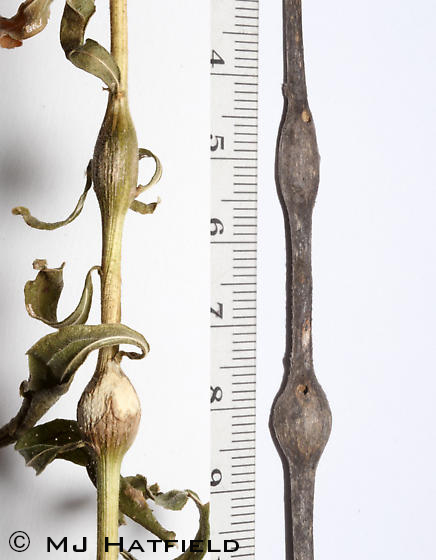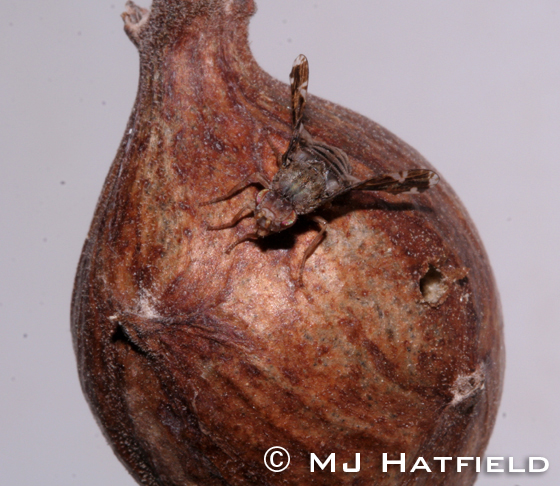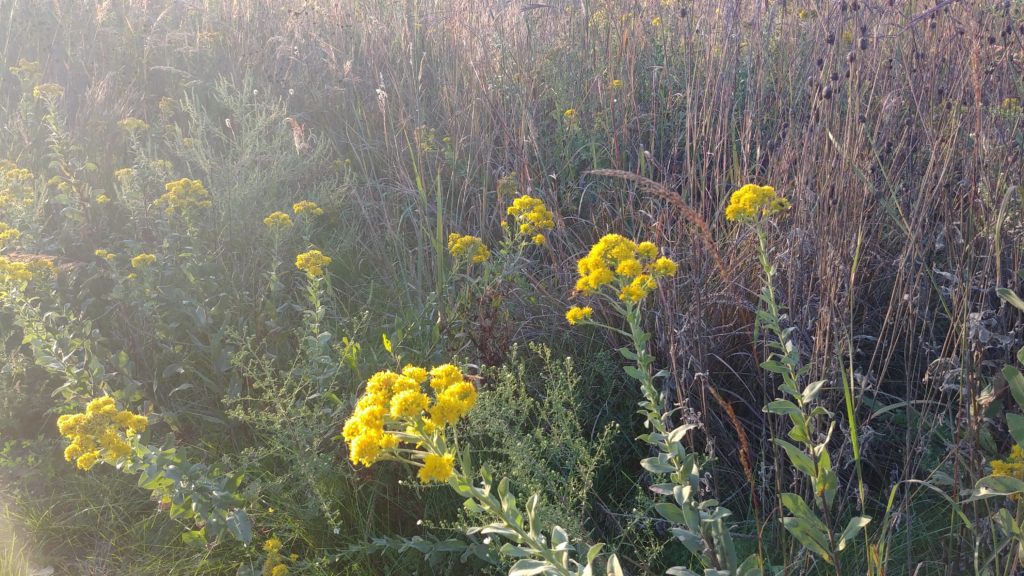The North American Prairie Conference was a big conference (638 people from 24 states and 2 countries) but not all the sessions dealt with big mammals, tall grasses, and wide open spaces. During a break from working the registration table, I caught some delightful talks by MJ Hatfield and Chris Helzer about the tiny creatures you can meet and the stories you can learn if you “walk slow, look close, and be curious” – MJ Hatfield.
Howdy! I’m a goldenrod gall fly (formally, Eurosta solidaginis). Have you ever seen flower stems with an odd, ball-shaped growth? These round growths are called galls, and if you’ve seen one on goldenrod, I may have been the architect that created it. But what exactly is a gall? To me, a gall is a highly specific and comfy nursery, created with a little hijacking (picture to the left © MJ Hatfield).
A gall can be about anywhere on a plant, including flowers and leaves, and are created by hijacking the plant’s hormones. You read that right. I’m a hormone hijacker. In spring, before I was born, my mother inserted her egg (me!) into the goldenrod’s stem. Later, when I hatched into a larva inside the goldenrod, I started eating the inside of the stem. My saliva contains chemicals that trick the plant into thinking the saliva is its own hormones. My saliva signals the goldenrod to grow more tissue in the feeding area (or nursery, as I like to call it). The goldenrod ends up creating a beautiful, round nursery. In short, I’ve built my very own gall. I’ll eat and grow in this goldenrod gall throughout the summer until fall. In autumn, I chew a tunnel near the outside of the gall and then pupate, waiting until spring to emerge. But how the heck am I supposed to get out of the gall?!
This is where it gets seriously interesting. I have an air bag like structure on my head between my eyes. I inflate this air bag against the gall, and bam! I break through, seeing the outside world for the first time. Also, this whole process doesn’t hurt the goldenrod. It nearly always flowers like normal and continues enjoying life as a goldenrod plant.
My species can’t survive in any other plant. Because I’m a weak flier, I will probably stay in the same neighborhood that I grew up in. I hope nothing happens to this patch of goldenrod…I’m not sure if I could make it to a different prairie patch. Maybe if there were more prairie plantings, it wouldn’t be so drastic if changes came to my neighborhood. The prairie restorations could act as a safety net.
As the goldenrod gall fly, my entire life and future requires the presence of goldenrod. And I’m not the only one! At least two moth species also make galls on goldenrod. There are quite a few bees that rely solely on goldenrod pollen. You might think we are picky, but can you imagine how hard it is to find a home that you can not only live in, but also eat? And us gall flies have to develop specific chemicals in order to hijack specific plant hormones to even make our home and food. It’s very complicated, and we can’t just change all that with a snap of our wings!
Many people now know that monarch caterpillars can only eat milkweed, and are planting gardens with milkweed to help them. That’s great, but monarch butterflies are not the only insect that needs a certain plant for food or shelter. Sawtooth sunflower has four different species of gall-forming insects that dependent upon it. The blue sage bee requires pollen it can only get from blue sage flowers. Swallowtail butterflies rely on plants in the carrot family (such as golden alexander). Make room for a diverse prairie planting and you could be supporting ten times as many species of insects, many of them so small or well-camouflaged that few people have ever met them!




